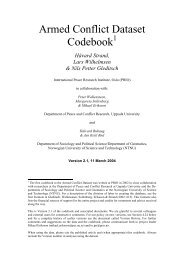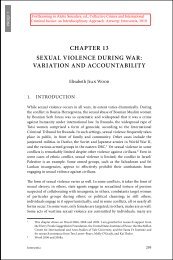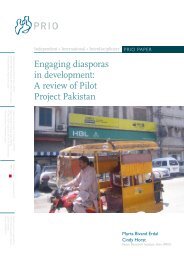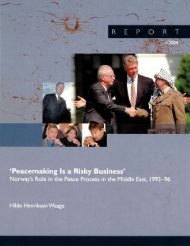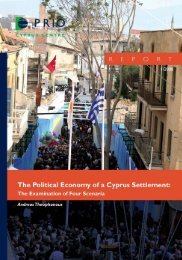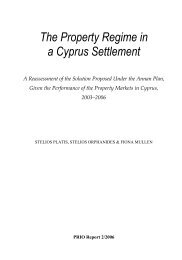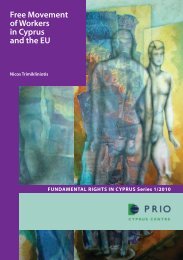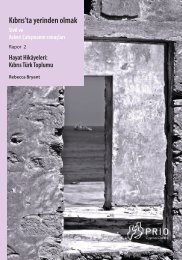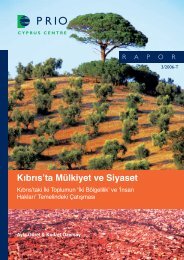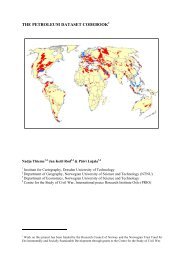A prime concern with <strong>Mine</strong> <strong>Action</strong> Centres is their viability. MACs are entirely dependent on internationalfunding, which again may serve as an obstacle <strong>to</strong> the natural and logical transfer of responsibilityfor mine action <strong>to</strong> existing indigenous entities. Accordingly, there should be a reassessment of howMACs are structured in order <strong>to</strong> ensure their transfer <strong>to</strong> sustainable national institutions. A furtherimplication is that responsibility for mine action should be placed with existing national capacities atthe outset of an operation, <strong>to</strong> the extent this is possible.Swedish capacitiesWhile Sweden has been one of the world’s largest donors <strong>to</strong> HMA, there is no Swedish NGO operatingin mine action. Instead, Swedish mine-action initiatives have come in the form of support <strong>to</strong>research and development projects, the secondment of technical experts and the <strong>Mine</strong> Detection Dog(MDD) initiative in Cambodia. Our review of these efforts suggests that in order <strong>to</strong> ensure that responses<strong>to</strong> the mine problem meet the needs of those affected by landmines, a concerted effort mustbe made <strong>to</strong> assess the relevance of projects. In practice, this means the identification of priorities asdefined by populations in individual mine-affected regions, countries or communities. These needsshould serve as the fundamental basis for initiating projects or programmes. Excluding the views andneeds of those in a mine-affected region jeopardizes the sustainability of initiatives and minimizespeople’s sense of ownership of programmes. In turn, the potential for creating long-term sustainableresponses is greatly reduced. More generally, Sida’s broad experience from humanitarian assistanceand development should be used <strong>to</strong> ensure that the necessary expertise and institutional arrangementsare in place from project initiation onwards. This would include a thorough assessment of all collaboratingpartners, as well as ensuring that all Swedish stakeholders identify with Sida’s HMA policy.Concluding remarksAlthough the most acute threats from landmine contamination may be largely under control withinthe next few years, the problem will still be far from eradicated. At the same time, there is an emergingdilemma in mine action <strong>to</strong>day. While there is a reorientation within HMA, under which new <strong>to</strong>ols andapproaches are being developed <strong>to</strong> deal more effectively with the problem of landmines, there is alsoa parallel decrease in international interest in the issue of landmines. It is therefore imperative for theinternational donor community <strong>to</strong> take steps <strong>to</strong> ensure that the opportunities that currently exist aretaken advantage of. The central challenges for mine action <strong>to</strong>day are <strong>to</strong> maintain political interest inthe issue, <strong>to</strong> ensure sufficient levels of funding and <strong>to</strong> promote responses that can lead <strong>to</strong> sustainablelong-term benefits for those most seriously affected by landmines.4 Sida’s CONTRIBUTION TO HUMANITARIAN MINE ACTION – Sida EVALUATION 01/06
1 IntroductionThis report examines the contribution of the Swedish International Development Agency (Sida) <strong>to</strong><strong>Humanitarian</strong> <strong>Mine</strong> <strong>Action</strong> (HMA). In the past few years, HMA has undergone what has been termeda ‘quiet revolution’. 1 Traditionally, measures of landmine contamination have focused on number ofmines per square metre, with scant attention paid <strong>to</strong> the impact of mines on communities and individuals;meanwhile, landmine removal has focused either on amount of land cleared or on <strong>to</strong>tal numberof mines removed. However, governments, organizations and the international community have come<strong>to</strong> recognize that landmines are an integral part of a greater humanitarian crisis, constituting significan<strong>to</strong>bstacles <strong>to</strong> the repatriation of displaced persons, the resumption of economic activity and therebuilding of society as a whole. In response, there has been a gradual shift within HMA, with greaterfocus being placed on social fac<strong>to</strong>rs and increased sensitivity <strong>to</strong> the impact of landmines on peoples’lives. Hence, the quiet revolution.Aims and scope of the reportThis evaluation examines this shift in HMA through an assessment of Sida’s contribution <strong>to</strong> mineaction. The report has two particular objectives and one broader and more general goal. The firstambition of this project is <strong>to</strong> assess Sida’s contributions <strong>to</strong> mine action. Through its support over thelast decade, Sida has become one of the world’s largest contribu<strong>to</strong>rs <strong>to</strong> mine action. By examiningprojects supported by Sida, this report outlines the relative merits of different approaches <strong>to</strong> HMA.The second ambition of this project is <strong>to</strong> establish guidelines for the future. By drawing on lessonslearned from the past, the report is designed <strong>to</strong> assist Sida in revising and developing its policy, and <strong>to</strong>provide future guidance for decisionmakers. With this goal in mind, the evaluation focuses on learningaspects and assesses individual activities, programmes and implementing organizations. The third andoverarching ambition of this report is <strong>to</strong> place mine action in a broader context, looking at how socialand political fac<strong>to</strong>rs impinge on HMA practices. As part of this, we attempt <strong>to</strong> sketch some of the keylinkages between societal fac<strong>to</strong>rs and their consequences for HMA. In this sense, the report is anchoredin an approach which emphasizes the social and economic impact that landmine contamination has oncommunities and individuals and examines how these impacts can be placed at the centre in theplanning and implementation of HMA. Further, because HMA is part of a broader humanitarianeffort, we attempt <strong>to</strong> sketch the links between HMA and other humanitarian initiatives. In the report,we examine four basic aspects of mine action:1. The role of impact assessment in HMA, with a focus on the strengths and weaknesses of fourapproaches: Rules of Thumb, Cost-Benefit Analysis, Composite Indica<strong>to</strong>rs and Community Studies.In order <strong>to</strong> illustrate the relative merits of each of these approaches, we draw on examplesfrom the cases of Afghanistan and Mozambique.2. The comparative advantages and disadvantages of different implementation channels, with ananalysis of NGOs and governments as implementers of mine action. In addition, we look at twoalternatives <strong>to</strong> these channels, namely the UN and commercial companies. In this section, we drawprimarily on case studies of <strong>Mine</strong>s Advisory Group (MAG) in Iraqi Kurdistan, Norwegian People’sAid (NPA) in Angola, and the military in Nicaragua.1Ananda S. Millard & Kristian Berg Harpviken, 2000. Reassessing the Impact of <strong>Humanitarian</strong> <strong>Mine</strong> <strong>Action</strong>: Illustrations fromMozambique, PRIO Report 1/2000. Oslo: International Peace Research Institute (PRIO).Sida’s CONTRIBUTION TO HUMANITARIAN MINE ACTION – Sida EVALUATION 01/06 5
- Page 4: This report is part of Sida Evaluat
- Page 9 and 10: MDDMEDDSMGMMLSWMoPHMOUMPLANATONDING
- Page 12 and 13: the conclusions of this report is t
- Page 16 and 17: 3. The coordination of mine action,
- Page 18 and 19: an needs and the needs of victims o
- Page 20 and 21: At the same time as Sida has been o
- Page 22 and 23: er, throughout the data collection,
- Page 24 and 25: Donors may feel that the costs of i
- Page 26 and 27: is genuinely new. 8 At an overall l
- Page 28 and 29: The first attempt to apply a form o
- Page 30 and 31: standard for basic impact surveys.
- Page 32 and 33: Community studiesCommunity studies
- Page 34 and 35: and progress monitored in all phase
- Page 36 and 37: 3 Implementation ChannelsOver the p
- Page 38 and 39: cal implementation and management,
- Page 40 and 41: ing that demining has any effect at
- Page 42 and 43: actual response. In an effort to ov
- Page 44 and 45: ecently developed. The approaches t
- Page 46 and 47: A different tool that will be used
- Page 48 and 49: Alternative implementation channels
- Page 50 and 51: appear to have been doing a good jo
- Page 52 and 53: Coordination may at times even be c
- Page 54 and 55: itarian and development effort. Imp
- Page 56 and 57: Two). In terms of coordinating mine
- Page 58 and 59: ased demining of AREA. Another type
- Page 60 and 61: The Kosovo UNMACC took a number of
- Page 62 and 63: would be accredited and tasked by U
- Page 64 and 65:
programme. The proposal was backed
- Page 66 and 67:
The present landscape of Swedish ac
- Page 68 and 69:
demining purposes. Buoyed by a wave
- Page 70 and 71:
given that SRSA also recruits perso
- Page 72 and 73:
teams. The need for a breeding capa
- Page 74 and 75:
6 RecommendationsIn the preceding c
- Page 76 and 77:
• MACs should operate with agreem
- Page 78 and 79:
7 ConclusionIn this report, we have
- Page 80:
70Appendix 1
- Page 89 and 90:
Ziauddin Operations Officer METADup
- Page 91 and 92:
Bennedich, Claes Department for eva
- Page 93 and 94:
Appendix 3BIBLIOGRAPHYAccelerated D
- Page 95 and 96:
Faulkner, F. & L Pettiford, 1998.
- Page 97 and 98:
McGrath, Rae, 2000. Landmines and U
- Page 99 and 100:
Miscellaneous DocumentsBrady, Justi
- Page 101 and 102:
Appendix 4Sida’s CONTRIBUTION TO
- Page 103 and 104:
Appendix 6• The area must be secu
- Page 105 and 106:
Appendix 7Locality identifier: Dist
- Page 107:
Recent Sida Evaluations00/37:1 Asse



